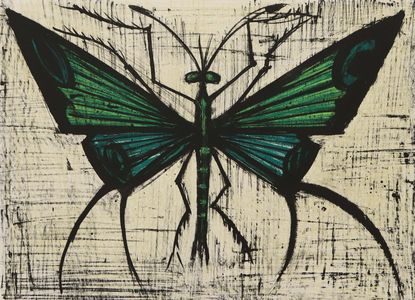
Bernard Buffet was born on July 10, 1928, in Paris, in the Batignolles district. He was the son of Charles Buffet and Blanche Colombe.
To his admirers, Bernard Buffet is pure genius. He was accepted at the Ecole Nationale des Beaux-Arts at the age of 15 years old. He stayed there for only two years and decided to work on his own. He was introduced to collectors by the painter Aujame. He was awarded the Prix de la Critique (1948) at 20 years old, in a tie with Bernard Lorjou. In 1955, Buffet won a poll organized by the magazine Connaissance des Arts, which voted him the best post-war French artist.
A miserabilism master, Bernard Buffet found his place in the world’s greatest museums.
Founded by by Kiichiro Okano in 1973, with a collection of nearly a thousand works, an entire museum has been dedicated to his work in Surugadaira, Japan
Bernard Buffet’s talent was discovered as early as 1947. Buffet entered “L’homme accoudé” at the Salon des Indépendants, and in December of the same year, he held his first solo exhibit at the Librairie des Impressions d’Art.
The recognition was immediate. Raymond Cogniat bought “Nature morte au poulet” for the Musée National d’Art Moderne de Paris.
His first work featuring angular figures put him immediately in the miserabilist expressionist movement represented by such talents as Francis Gruber and Georges Rouault.
He met the art dealer Emmanuel David the following year, in 1948.
The latter was truly at the origin of his international career with a first exhibition at the Galerie Drouant-David in 1949.
Bernard Buffet signed an exclusivity contract with David who extended it to Maurice Garnier from 1957 on. Maurice Garnier gained the total exclusivity of Buffet’s production after 1968.
Paint supplies are expensive, Buffet saved by putting only small touches of paint on his canvases. Minimal material, therefore few colors, mostly gray, blacks, bistres, and greens.
His works are strong and poignant; the drawings, determined, lengthen like a supplication. Grey faces, wrinkled foreheads, straight or thin hair, tense hands, his figures seem crucified.
Bernard Buffet’s style is so moving that Monsignor Pasquale Macchi, Pope Paul VI’s secretary, asked the artist to donate some of his art to the Vatican. Bernard Buffet later sold a set of paintings representing the Passion of Christ, done in 1961 to decorate the chapel of the Château l’Arc he purchased in 1956.
The Galerie Charpentier in Paris organized the first retrospective of his work in 1958.
That same year, Buffet met and married Annabel Schwob who became his muse and companion of a lifetime.
From then on, the painter’s pictorial style evolved and blossomed, gaining in strength and color.
A recent exhibition organized at the Musée du Touquet from Nov. 16, 2015, to Jan. 10, 2016, titled “Une Symphonie de Couleurs en plus”, allowed the public to rediscover his long-forgotten early production.
His references are varied: many works pay tribute to Grünewald, Rembrandt, Chardin, Van Gogh, and others.
Bernard Buffet illustrates perfectly the split between French Contemporary and Figurative art.
A popular artist by excellence, Bernard Buffet is embraced by the public, despite the disdain of the elites who blame him for being too prolific, too figurative, and not intellectual enough.
To his 8000 canvases, watercolors, drawings, lithographs, and etchings, we can add sets for shows, costumes, as well as two stamp projects (1978 and 1991). In this, he rejoins Renoir and Picasso, two very productive artists.
He was appointed to the Academy of Fine Arts in 1974, promoted to the rank of Officer of the Legion of Honor in 1993 and Officer of Arts and Letters.
This attests to his indisputable recognition, regardless of the dislike long held against him by the French intelligentsia. It was not in good taste to appreciate Bernard Buffet’s work. Lydia Harambourg was the only art critic that continued to defend his work.
It doesn’t matter. Spiritual, whole, sensitive, tormented, Buffet was a free spirit that his detractors had freed from any desire to please. “The Hate that surrounds me,” he said, “is for me the most wonderful gift I’ve ever been given. I don’t have to spare anything or anyone. Few people can say the same. Having dedicated his life to painting, the only real goal of an existence devoted to the creation, Buffet put into practice his saying as reported by Stéphane Laurent: “When you have nothing more to say, you commit suicide”.
The symptoms of Parkinson’s disease appeared in 1997. On October 4, 1999, no longer able to paint, Bernard Buffet put an end to his life on his estate in Tourtour, by suffocating himself with a plastic bag on which his signature had been copied.
Selected Museography
– Vatican Museum, modern art gallery. “The Passion of Christ”, dated 1961.
– Bernard Buffet Museum, Surugadaira, Japan.
– Museum of Modern Art, Paris. France.
Selected Bibliography
Bernard Buffet, ed. Bernard Buffet Endowment Fund, 2013.
BUFFET Annabel and LAMY Jean-Claude, Bernard Buffet : Workshop Secrets, photogr. Luc Fournol and Benjamin Auger, Flammarion, 2004.
CAMUS Brigitte, Buffet ou la psychanalyse en signature, Epure, coll. Essais sur l’art et la création, 2007.
HARAMBOURG Lydia, Bernard Buffet et le Bretagne, Plomelin, Ed. Palatines, 2006.
LE PICHON Yann, Bernard Buffet, ed. Maurice Garnier, 3 vol.
PERIER Henry, Bernard Buffet et la Provence, Plomelin, Ed. Palatines, 2007.
SILLEVIS John, Bernard Buffet, Plomelin, Ed. Palatines, 2013.
SORLIER Charles, Bernard Buffet lithographer, volume I: 1952-1979, Monte-Carlo, ed. André Sauret, 1979.
SORLIER Charles, Bernard Buffet lithographer, volume 2: 1979-1986, Monte-Carlo, ed. André Sauret, 1987.
Une Symphonie de couleurs en plus, cat. expo. Musée du Touquet-Paris-Plage, 2015.




